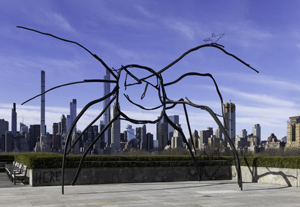8.9.24 — The Last Dance
To wrap up from last time on New York summer sculpture, Suchitra Mattai saves the last dance for herself and her memories. The Broadway billboard over the entrance to Socrates Sculpture Park is not, strictly speaking, sculpture—or even part of many a summer show. More often than not, it devolves to a different artist entirely. Here, though, the sculptor herself gets to introduce the park and her work, and it is an upbeat introduction.
Mattai depicts little girls in a circle dance, with tapestries behind them and flowers at their feet to either side. It may not have you in the mood for a dance, but you can imagine dancing going on inside. 
Queens residents flock to the enclave by the waterfront for the sunshine or the view. The BBQ pit by Paul Ramírez Jonas, is gone, but a flashy new construction offers shelter for movie nights. Still, this is Mattai’s dance, to celebrate, she says, her “past, present, and future Indo-Caribbean ancestors.” The girls may have darker skin than hers, but her celebration extends widely, from her birthplace in Guyana to “diasporic communities” and their “migratory oceanic journeys.” Forget the refugee camps of Petrit Halilaj on the Met roof. Here We Are Nomads, We Are Dreamers, through August 25.
Their art seeks shelter, under a dome of arched branches and leaves, and lurks in the trees, where fabric spheres descend like wrecking balls. Out on the lawn, six colorful works could themselves be tree trunks, were they not so thick and colorful. Mattai has sliced them all right through at a diagonal, in one clean cut. Squirrels may still seek their own shelter through small holes at their base, and the mirrored cuts shine. In spring, they glistened with water from sprinklers tending to the park’s slightly ratty grass. I could imagine them fresh with dew.
Cannupa Hanska Luger counts himself a descendent of the Buffalo people, and he identifies the near extinction of the American bison with the loss to “extractive colonizers” of Native Americans as well. Now the hairy animals again once roam the plains, and he sees them as a symbol of sovereignty and resilience. You might not know it, though, from his ash-black bison in City Hall Park, dead on its back. Not that Luger ever settles for happy endings or, conversely, things as they are. He brought mythic creatures from the white desert sands of his New Mexico to Wave Hill in 2022. He brought, too, an inverted Lakota tent to the 2024 Whitney Biennial for “intergenerational protection” turned upside-down.
The ten-foot skeleton rests not on a lawn, but on a bed of grass from tribal America, through November 17. Each summer, an artist gets free run of park’s sparer grass and walkways. Luger prefers a single work. Alone it becomes a monument, even flat on the ground, on the path to City Hall. Alone, too, it can better stand for loss, with a work titled Attrition. Either way, he is making demands and pointing the way to change.
Summer sculpture as become more and more responsive to its surroundings. To end where I began, Rose B. Simpson has her heroine rise out of the grass and sod of Madison Square Park—unless she has sunk into it up to her waist. She has, though, “guardians” to protect her. That term harkens back to David Smith, as does their height, their steel, and their planar composition. Two more stand guard over a lonely corner of Inwood Hill Park, by the northern tip of Manhattan, for the determined few to find. But then Simpson has long since made up her mind about who is in touch with the city and the earth.
Read more, now in a feature-length article on this site.